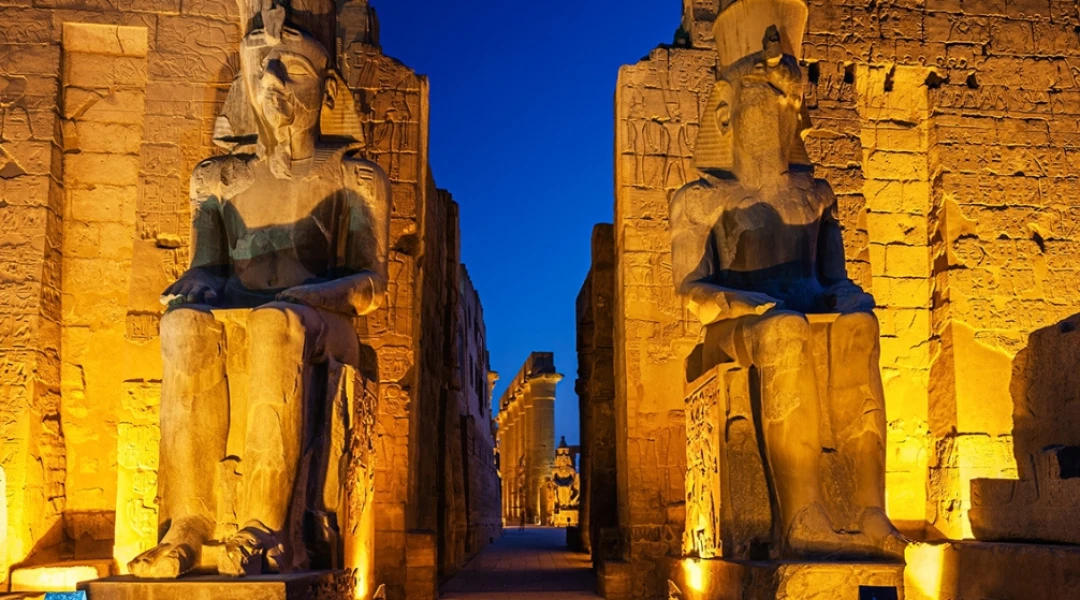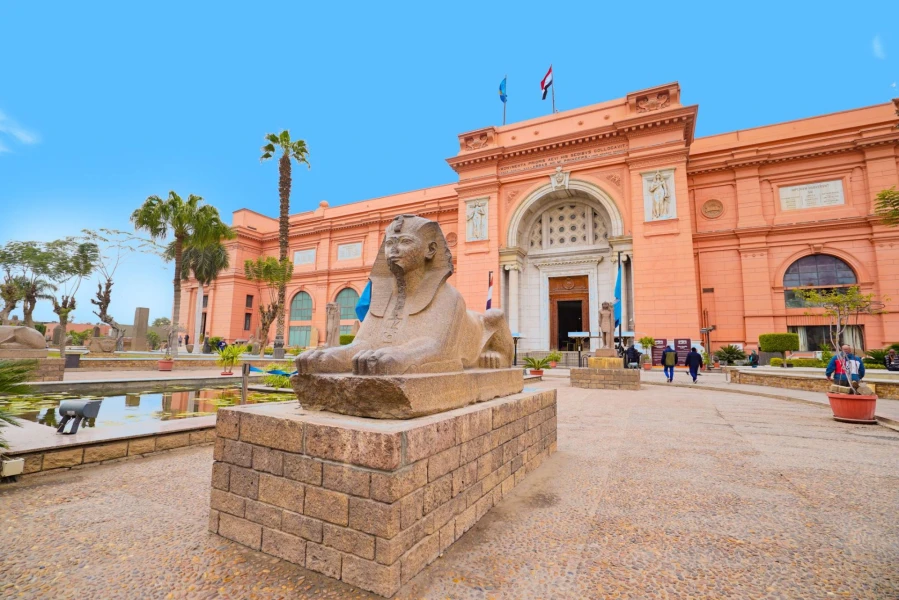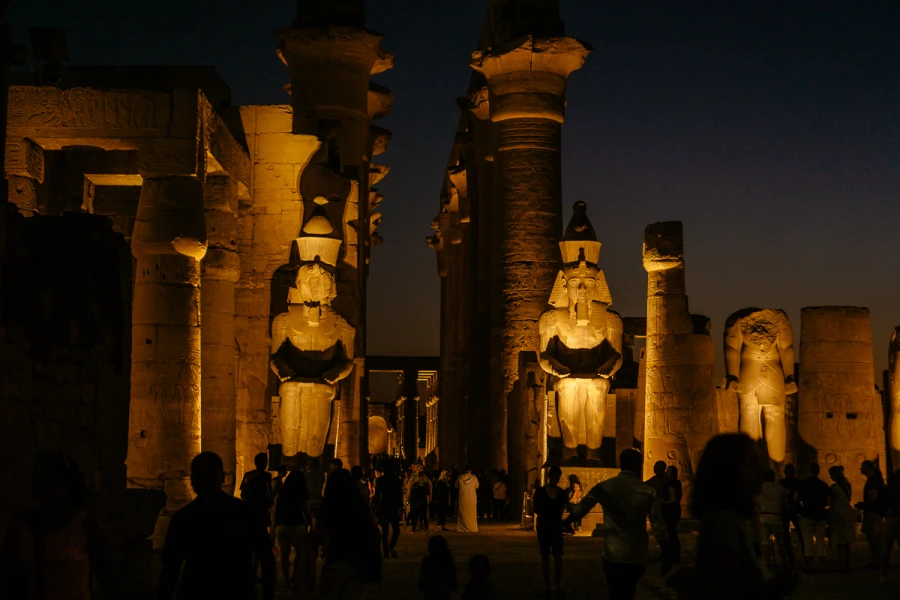Colossi of Memmon History
Meet the Colossi of Memnon: 3,400 Years of Egyptian Majesty
The Colossi of Memnon are two massive stone statues that have stood for nearly 3,400 years in the Theban Necropolis, located west of the River Nile near the modern city of Luxor. These grand statues depict Pharaoh Amenhotep III, who reigned during the 18th dynasty of ancient Egypt. The statues are among the most iconic monuments included in Egypt tours and Luxor tours, attracting thousands of visitors interested in ancient Egyptian history and architecture.
When in their heyday, the Colossi of Memnon guarded the entrance to the pharaoh's temple complex, welcoming guests and pilgrims who came from all directions to honor the king who had passed away. Encircling the statues were expansive courtyards, halls, and chapels that displayed the riches and authority of Amenhotep III's rule through their elaborate carvings and sculptures.
Nevertheless, the temple complex has suffered over the ages, and hardly much of its original splendor is visible today. Even after suffering weathering, natural disasters, and human intervention, the Colossi of Memnon captivate attention as timeless reminders of ancient Egyptian culture.
One of the renowned legends shared across memories concerning the Colossi is the mysterious "singing" by the northern statue at dawn. The ancients recorded that this strange sound was supposed to occur when the first rays of sunlight warmed the stone, the strange single-string note of a harp, some said. The spectacle of nature charmed any visitor who sought to believe that the sound was the very voice of the Pharaoh, blessing them with supernatural powers. These interesting-facts-trips about the Colossi made it a very popular pilgrimage site in history where travelers sought mystery, magic, and a tie to divinity. This phenomenon remains one of the most intriguing parts of Colossi of Memnon History.

A Journey Through Time: The Fascinating History of the Memnon Colossi
The Memnon Colossi, Engraved around 3,400 years ago from enormous slabs of quartzite sandstone, these commanding sculptures formerly graced the entrance to Amenhotep III's mortuary temple, serving as a reminder of the pharaoh's immense riches and influence at the pinnacle of the New Kingdom era. You can learn a lot through Egypt tours Where you can choose a suitable trip to Luxor to discover its ruins
At the front of Amenhotep III's temple, the Colossi of Memnon welcomed guests and pilgrims who came to honor the esteemed pharaoh. Originally, they were a part of a large complex that spanned the Theban necropolis. Encircling the doorway like massive sentries, the sculptures showed Amenhotep III astride his throne, his eyes fixed in the distance.
Each statue, which was over eighteen meters high and weighed an estimated 700 tons, was decorated with elaborate carvings that included hieroglyphic inscriptions honoring the pharaoh's divine ancestry and achievements. Huge courtyards, halls, and chapels filled with sculptures, obelisks, and reliefs surrounded the colossi, creating a magnificent scene worthy of the head of one of the most potent ancient empires. Luxor trips provide you with an irreplaceable opportunity. You can choose a trip to the city full of legendary temples and learn the secrets of the great pharaohs.
Amenhotep III's temple deteriorated throughout the ages as the weather and passage of time wore down its formerly magnificent constructions. With the exception of the Colossi of Memnon, which have survived as enduring representations of the majesty and grandeur of ancient Egypt, little much of the original complex is visible today.
Where is the Colossi of Memnon located?
The Colossi of Memnon are located on the west bank of the Nile River, opposite the city of Luxor. This area, known as the Theban Necropolis, is rich in historical and archaeological sites, making it a must-visit destination on Egypt day tours. The statues are situated at the entrance of what was once Amenhotep III's mortuary temple, one of the largest temples built in ancient Egypt.
The "vocalization of Memnon" is a phenomenon associated with the Memnon Colossi that is one of its most fascinating features. There were old stories that at dawn one of the statues would make an enigmatic sound, like the plucking of a harp chord. Visitors and pilgrims traveled from far and wide to witness this phenomenon, which was ascribed to the stone expanding in the morning light. They thought the stone represented the voice of the departed pharaoh, bestowing gifts from the afterlife. - A tour of the Valley of the Kings, the Temple of Hatshepsut, and the Colossi of Memnon, one of the most beautiful tours during which you can explore the great statue with a tour guide to tell you all the history of the great statue.

Standing Tall: The Historical Significance of the Memnon Colossi in Luxor
- Significance in Politics:
Building colossal sculptures, like the Memnon Colossi, was a political declaration of authority and strength as well as an expression of religious devotion. Amenhotep III aimed to display his power, riches, and divine right to rule with his grand construction projects, like as the Colossi of Memnon and his funerary temple. Amenhotep III aimed to establish his authority over Egypt and its subordinate nations and to strengthen his legacy via the construction of these enormous temples. - Discoveries in Archaeology:
Egyptology and archaeology have both benefited greatly from the Memnon Colossi. They were noticeable monuments that drew the interest of early explorers and travelers due to their enormous size and conspicuous placement. From ancient Greek and Roman periods, the sculptures have been known for millennia and have been the focus of research and excavation. Archaeological studies conducted in the vicinity of the Memnon Colossi have provided important new understandings of ancient Egyptian art, architecture, and religious customs. - Preservation Activities:
The Memnon Colossi is threatened by pollution, natural erosion, and tourism; nonetheless, attempts have been undertaken to save it for future generations. Steering toward stabilization, halting further degradation, and guaranteeing the sculptures' long-term survival are the goals of conservation initiatives backed by global organizations and local governments. The Memnon Colossi continue to astonish and amaze tourists from all over the world and serve as enduring emblems of Egypt's rich cultural legacy thanks to these preservation efforts.
Who is Memnon?
In Colossi of Memnon history, Memnon is a very famous figure from Greek mythology: He was a mighty king of Ethiopia and a great warrior known for his valor in the Trojan War, fighting on the side of the Trojans. Memnon was said to be the son of the dawn goddess Eos. Ancient art depicts his heroic yet tragic death at the hands of Achilles, thus elaborating the myth. Such a mythical connection lends an enchanting weirdness into those colossal statues, elevating them beyond just monuments into emblems of legend and mystery. making the attractions interesting for anybody on Luxor excursions or Egypt tour packages
Seeing the Statues of Memnon represents a unique experience in witnessing the powerful blending of Egyptian culture and ancient mythology. The ever-iconic giants stand eternal as witnesses to the cultural crossroads that shaped not just Egypt but strikes also beyond into other civilization. Most Egypt Nile river cruise include the statues in their itineraries, along with excursions through Luxor. Their presence is a call to travelers to delve into the historical, mythological, and artistic layers lying deep under the truly singular heritage of Egypt

The origin of Colossi of Memnon’s name
Opinions for why Akhenaten built Colossi of Memnon have a connection to Greek mythology as the statues were named “Colossi of Memnon.” The statues were venerated in the Hellenistic period with Memnon, a son of Eos, the goddess of dawn, who was assumed to be an Ethiopian king. What probably gave them this character was that Memnon was reported to have been killed by Achilles during the Trojan War. The Greeks had thought that one of the statues issued a sound in the morning, and this sound was thought to be that of Memnon addressing his mother Eos. This occurrence where the stone got heated in the morning light as people passed nearby made the statues a landmark for the ancient travelers and contributed to their lore, guaranteeing them inclusion in the many forms of Classic tours in Egypt..

When were the Colossi of Memnon built?
Amenhotep III was one of the more productive Pharaohs of ancient Egypt’s 18th Dynasty who ruled Egypt from 1386 to 1349. In his rule this area enjoyed prosperity and thus we have the name for this period of Ancient Egypt bestowing the title of Old Kingdom. Architecture during the Old Kingdom was fruitful in Egypt, and most of these structures can seen to date today.
Most of these grand structures were erected in Amenhotep III’s hist 39 years reign; One of the great structures was the Colossi of Memnon constructed prior to 1350 BC. The Colossi of Memnon was built in front of a false door of Amenhotep III king’s temple (which was used as a supply depot and was destroyed by an earthquake shortly after the king’s death). This structure was originally built to act as a funerary temple for Pharaoh Amenhotep III. After it was moved through the earthquake in the 27 the Colossi of Memnon was cracked and was repaired and was maintained by the Roman emperors in the Roman Empire within ancient Egypt.



















-webp.webp)


















-webp.webp)



-webp.webp)
-webp-webp.webp)
-webp-webp.webp)
-webp-webp.webp)
-webp-webp.webp)
-webp-webp.webp)
-webp-webp.webp)
-webp-webp.webp)
-webp-webp.webp)
-webp-webp.webp)
-webp-webp.webp)
-webp.webp)
-webp-webp.webp)
-webp-webp.webp)
-webp.webp)
-webp.webp)
-webp.webp)
-webp-webp.webp)
-webp.webp)
-webp-webp.webp)
-webp.webp)
-webp.webp)
-webp.webp)
-webp.webp)
-webp.webp)
-webp-webp.webp)
-webp-webp.webp)
-webp-webp.webp)
-webp-webp.webp)
-webp-webp.webp)
-webp-webp.webp)
-webp-webp.webp)
-webp.webp)
-webp-webp.webp)
-webp-webp.webp)
-webp-webp.webp)
-webp-webp.webp)
-webp-webp.webp)
-webp-webp.webp)
-webp-webp.webp)
-webp-webp.webp)
-webp-webp.webp)
-webp-webp.webp)
-webp-webp.webp)
-webp-webp.webp)
-webp-webp.webp)
-webp-webp.webp)
-webp.webp)
-webp.webp)
-webp.webp)
-webp.webp)



